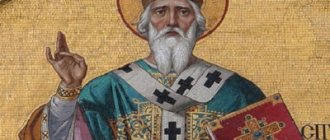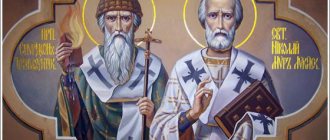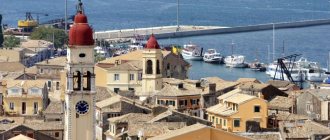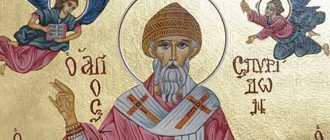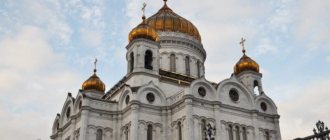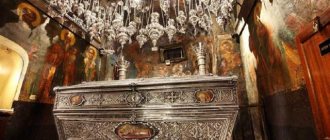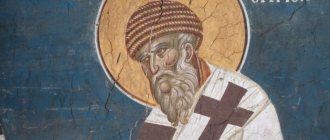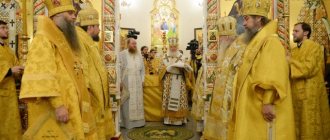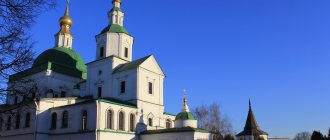Boots of Saint Spyridon of Trimifuntsky
Share
Boots of Saint Spyridon of Trimifuntsky. Photo: https://ortodoxia.me/
Sometimes you can hear from people who are involved in science the opinion that miracles in the Orthodox Church are an unprovable thing. Well, what other miracles?! - they exclaim. - This is all fiction! But there are relics in the Orthodox Church that can only be called miraculous. Moreover, even from the point of view of secular science.
To see one of these wonders, you need to come to the Greek island of Corfu or, as the Greeks call it, Kerkyra. The relics of St. Spyridon of Trimythous have been kept there for centuries.
Saint Spyridon lived in the fourth century on the island of Cyprus and during his lifetime became famous for his numerous miracles. For a long time he was the bishop of the city of Trimifunt, and after the death of his wife (at that time bishops could still be married) he began to wander around the island, here and there performing various miracles. Through the prayers of Saint Spyridon, healings from various diseases took place. It also happened that he resurrected the dead.
When Saint Spyridon died, his body refused to succumb to the decay common to all people. At first the body of the saint was kept in Cyprus, then it was transported to Constantinople. After the capital of Byzantium fell under the attack of the Turkish army, the relics of Spyridon were transported to Corfu, where they are still kept.
Many of the saint's miracles are officially documented. However, modern people find it difficult to believe in them. Usually, skepticism towards the miracles of Saint Spyridon disappears when you approach his shrine, that is, the precious ark with his relics. At this moment, everyone has the opportunity to meet Saint Spyridon face to face.
The fact is that the relics of the saint are not covered with a veil and therefore it is possible to clearly see his face. It is very well preserved. The saint's features are completely recognizable; his hair and teeth are perfectly preserved. The skin, although slightly wrinkled and darkened, nevertheless retained its shape. The body of Saint Spyridon has a constant temperature - 36.6 degrees, like that of a healthy living person.
There is another surprising fact. The body of the saint is dressed in bishop's vestments. The guardians of the relics have to change this vestment every six months, because it... wears out. The boots the saint wears also wear out. It’s as if Saint Spyridon is not lying in a shrine, but is constantly walking. Residents of Corfu directly claim that even after his death the saint did not abandon the custom of traveling, and therefore constantly walks around the island and helps those who need it. The priests cut the worn clothes of St. Spyridon into small pieces and distribute them as relics to pilgrims.
Scientists from all over the world tried to study the phenomenon of the incorruptible relics of St. Spyridon. The Greek Church did not prevent them from doing this. However, having studied the relics of the saint, the scientists only threw up their hands. They could not give any other explanation other than a miracle.
Life of Saint Spyridon of Trimifunt
On the northern part of the island of Cyprus, near the village of Trimitusi (Trimifunta), the village of Askia is located. Here, at the end of the 3rd century, the future saint was born.
There is very little information about his parents and adolescence. It is only known that God’s chosen one was distinguished by simplicity, obedience, piety and compassion for the poor, and his occupation was herding goats and sheep.
Having married a pious girl, he lived with her for a short time. Some time after the birth of their daughter Irina, the wife died, and Saint Spyridon was forced to raise a small child alone.
The Monk Simeon Metaphrastus writes in his writings that the wonderworker Spyridon spent his time imitating the psalmist David in meekness, the Patriarch Jacob in simplicity of heart, and Abraham in hospitality.
For their godly life, the Trimitus Christians convinced Spyridon to become their bishop.
Having been elected to a place of honor, the saint continued his previous activities: he tended sheep and cultivated the land, giving a significant part of his funds to help those in need, leaving only meager food for himself.
For his humility and purity of heart, God rewarded the saint with many grace-filled gifts: insight, miracles, and the greatest boldness in prayer.
Until his last days, Saint Spyridon was in good health and worked together with the peasants.
The miracle worker died at a very old age, after eighty years.
Saint's shoes
According to legend, in them the saint tirelessly travels around the world, looking for those who need his help. Gifts of gratitude to Saint Spyridon hang above the shrine with the relics. Among other things, there are many boats here that received an answer to their petition through the miraculous help of the saint.
Slipper of Spiridon of Trimifuntsky
In the shrine lie the incorruptible relics of the saint. His head lies on a pillow and is slightly tilted - the saint seems to have fallen asleep for a while. You can see facial features, nose, lips, eyes closed. Despite the fact that these relics are one thousand seven hundred years old, it has a constant human temperature. If you touch it, a dent remains, which gradually levels out. And you begin to realize that this body is imperishable.
The sarcophagus is opened twice a day for worship by believers, but sometimes this fails because the lid is jammed. Believers believe that the saint is absent from cancer at this moment. He goes somewhere and helps those who are suffering and in need of consolation and protection. During the religious procession, the saint walks through the streets of the city, blessing everyone he meets.
| When during the religious procession they carry St. Spiridon, you can see that he is leaning on his legs. Before the incorruptible relics are again transferred back to the shrine, they are first carried around the temple three times. Saint Spyridon, as it were, finally blesses those praying.
The grace emanating from the saint goes to every believer. And in these shoes he goes to those who need his help. Slippers are changed every year. The old ones are distributed to people, donated to churches built in honor of St. Spyridon. And since there are not enough shoes for everyone, 2-3 meters of burgundy (red vogozarikirosarikirosaritirikitirozarikirik) are placed in the shrine of the saint
And after that they divide it into thousands, millions of small pieces and distribute it free of charge to everyone. They are called “filahto” in Greek.
Important! Receiving filahto is a special blessing for every person. And when this shrine is nearby, it serves as protection for the believer. You can also purchase filahto via the Internet, pay only for postage at the rates of that country.
Why do the shoes of Spyridon of Trimifuntsky wear down?
Thank you for visiting our website, before you start reading, you can subscribe to an interesting Orthodox mailing list, for this you need to click on this link “Subscribe”
Once at a meal, our (now ever-remembered) wise abbot, Father George, said: “Whoever prays to Saint Spyridon of Trimythous will never be in need. Pray to him and you will not be left without a piece of bread.” And he began to tell the life of the saint.
We froze, and the light of the bright Mediterranean sun spread before our eyes, the red tiled roofs sparkled over the white sandstone walls, the branches of old olive trees swayed, a sea wave crashed near the coastal rocks, showering with water dust, and the serene blue of the sky covered everything from above. God-blessed land, warm sea, sun, silence of the night with the ringing of cicadas, close stars.
Where is the piece of “filahto” located in Moscow?
Sometimes, with the blessing of the current bishop of Corfu, the shoes taken from the saint’s feet are placed in a reliquary and donated to other Orthodox churches. Spiridon's shoes have been known in Russian churches since the 18th century (more often, however, not the shoes themselves, but particles - filahto).
In the Danilov Monastery
The shoe of St. Spyridon in a special icon case was donated in 2007 by Metropolitan Nektarios of Kerkyra to the Danilov Monastery. The shrine with a particle of the relics of St. Spyridon of Trimifuntsky is kept here and now in the Intercession Church. Monastery address: Moscow, st. Danilovsky Val, 22. Metro Tulskaya, Shabolovskaya, Auto class=”aligncenter” width=”400″ height=”559″[/img]
History of the relics
Saint Spyridon died during prayer. At that time he was already 80 years old. This happened in 348. Until the mid-7th century, his relics were kept in the city where he served as bishop - Trimifunt. Then the saint's body was transported to Constantinople due to the Arab invasion. After the city was captured by the Ottoman Turks, the relics were taken out in 1453 through Serbia to the island. Corfu.
Corfu is one of the most beautiful islands in Greece, located northwest of the mainland. It is the only Greek territory that was not conquered by the Ottoman Empire. It is quite large, the local population is predominantly Greek. In the capital of the island, in a tangle of narrow streets, there is a church in honor of St. Salochka
Relics of Spyridon of Trimifuntsky in the temple in Corfu
Any passerby will eagerly direct you to the temple of St. Spyridon. The city residents have this tradition. Many people in the morning, heading to work, always try to be blessed by the saint. The same goes for children when they go to school. First they go to Saint Spyridon, and only then to their lessons. They all do this not out of habit, but consciously.
Four times a year religious processions take place in Corfu, in which Spyridon himself participates:
- 11th August.
- Palm Sunday, deliverance from the plague;
- 1st Sunday in November, also an escape from the plague;
- before Easter, on Holy Saturday, help from terrible famine.
The most massive celebration takes place in Corfu on August 11, when they remember the miraculous deliverance of the Lenilenikimanikotekoteteletelen. On that memorable day in the summer of 1616, when the siege of the city began from all sides, residents came running. The chances of surviving were not exceeded.
Before the start of the assault, a very heavy, lingering rain began to fall, and a storm began on the sea, pogubikichnekikermanikermarubikerm The ground assault, abandoning the cannons in the water-filled trenches, hastily retreated to the remaining ships. The Turks, having suffered such losses, without even engaging in battle, retreated from Corfu and did not approach again. The memory of these events is kept in the memory of many generations; gratitude to the saint is immeasurable.
The saint repeatedly protected Corfu from enemy invasion. During the second world war, when bombs were falling on the island, it happened in the next roundhouse - Spiridon, calling on him for help.
The bomb that hit the church did not explode. Therefore, everyone who was hiding in the temple remained alive and was miraculously saved. This served as evidence that the saint did not leave the island and camps as his patron.
Read more about the saint:
- Hand of Saint Spyridon
- Feast of Spyridon Trimifuntsky
- Prayer for wish fulfillment
What are they asking for?
This saint of God lived and labored 17 centuries ago in Greece, but gained great popularity among the Russian people. Through his prayers, the drought ended and the rains fell, those in need received help, and sinners were admonished.
Wonderworker Spyridon of Trimifuntsky
Thousands of people stand in line to venerate the relics of St. Spyridon. Sometimes they have to stay overnight all night. In their prayers to him, believers ask:
- well-being in the family,
- health,
- assistance on the road,
- solutions to everyday problems,
- about real estate,
- about debt repayment,
- much more.
Advice! Especially Spiridon of Trimifuntsky helps in financial and everyday difficulties, and is a good assistant in business and business matters. The saint is also known as the patron saint of children. Parents offer prayers to him for their health and well-being.
Spyridon of Trimifuntsky, by the grace given to him by God, hears and accepts prayers from all corners of the Universe.
What did the old man look like?
By his appearance, you can unmistakably recognize Saint Spyridon on icons; you won’t confuse him with anyone. On icons he is depicted wearing a simple shepherd's hat, called a kidar, woven from palm branches. This simple shepherd's tiara became more glorious to him than all the well-decorated episcopal mitres.
The people in Trimifunt revered their shepherd, although he lived simply and was always seen dressed in the most modest clothes. In his hands he carried a palm staff, and on his neck a clay vessel, in which the holy oil from the Cross of the Lord was usually kept.
One day, this wretched outfit misled the arrogant courtier, who, seeing a poor wanderer entering the palace, hit the bishop in the face. And the saint, with humility, turned the other cheek to the angry one, according to the commandment. The taken aback nobleman only then, having regained his sight, saw who was standing in front of him.
Ashamed of the saint’s meekness and asking for forgiveness, he led Spyridon to the palace to the Emperor Constantius, who had long been suffering from an incurable illness.
The monarch had a dream in which an Angel named the name of a person whose prayer could heal this serious illness, and the whole court was waiting for Spiridon.
As soon as Constantius, standing up, bowed his head under the blessing of the Bishop of Trimifuntus, entering the throne room, and the hand of the saint touched the august head, the emperor was delivered from suffering, completely healed.
In gratitude for the miraculous help, the sovereign began to offer the bishop gold, but he refused, because he came to the palace for the glory of God, and not for a reward.
The emperor insisted, then Spyridon gave the sovereign and the entire court a pastoral lesson in selfless service to God and people: having accepted the gold and leaving the palace, he distributed everything to the poor.
Shocked by the saint’s dispassion and indifference to earthly wealth, the emperor himself distributed rich alms to the poor and from then on ordered the holy Church to be freed from taxes to the state treasury, for “it is indecent for the servants of the Immortal King to pay tribute to a mortal king.”
Miracles during and after life
Among the episodes in the life of the saint, which clearly signify miraculous faith and special chosenness, there is a story about his victory in a dispute with an Aryan philosopher at the First Ecumenical Council in Nicaea in 325.
Then, among the 318 members of the Council, wise men and righteous men who debated in defense of the Orthodox faith against the teachings of the wicked Arius, there was one simpleton - the former shepherd Spyridon, who, without words, with the help of God's inspiration, simply and clearly smashed the arguments of the Gnostic sophisticated mind that limited the existence of the Son God's
Because “the preaching of Christ is not in the words of human wisdom, but in the manifestation of the Spirit and power.”
Spyridon showed the Trinity of God - the Father, the Son and the Holy Spirit - the Consubstantial and Indivisible Trinity, taking a brick in his hands, squeezing it - water flowed down, fire rushed up, clay became in his hand.
The demonic force was afraid of Spyridon’s holiness, struck down by God’s grace, pagan idols fell from his approach. Through his life-giving prayer, vessels were filled to the brim with oil, the flow of rivers stopped their flow, destructive droughts were revived by rain, the dead rose, returning to life.
He was a seer and saw through the human soul, healed secret sins, and brought deceivers to repentance.
Spyridon is a healer of the passions of love of money and covetousness. Thus, he healed a merchant who wanted to deceive him to keep the gold he had borrowed.
Spiridon always allowed the person asking for a loan to take what he needed from the pantry. The borrower exclaimed: “Won’t you come and see, what if I take away more than I ask?” Spiridon replied: “You will not take away more than you need, but you will return as much as you can.”
The deceiving merchant, having used the debt and brought it back for repayment, went to the storeroom, but only out of greed kept it and did not invest it back. And from this excess he soon went bankrupt. Having lost everything, in need the deceiver again came to ask for help from the saint.
In response to the merchant’s request for money, Spiridon, smiling through his gray mustache, sent him to take as much as he needed from the treasury. But there was nothing to take there. The covetous man had to ask for forgiveness from Spiridon and repent before God. Only by repenting and asking for the saint’s prayers was he able to change his situation.
Miracles continued even after the repose of Saint Spyridon of Trimythous. When the grave was opened many years after his death, they found incorruptible relics with soft skin and recognizable facial features. In the 7th century, the relics of the saint were transferred from Cyprus by order of Emperor Justinian II (685-695) from the danger of capture and desecration to the capital of Byzantium and remained there until the mid-15th century.
After the fall of the empire, the shrine was transported from Constantinople first to Serbia and then to Corfu. In 1589, a temple was consecrated in Kerkyra in honor of St. Spyridon, where he still resides in his venerable body. Local residents consider him their patron and master of the island.
In Kerkyra they say how one fisherman often laughed at the faith of his fellow countrymen in the miracles of Spyridon, although he himself bore the name Spiro (Spiridon). But one day he got caught in a storm and fell overboard, drowning. He was drowning, but suddenly he found himself on the shore. Having come to his senses and remembering how he shouted the last prayer, and the hand pulling him from the abyss, he ran to the temple to check his guess.
And in the church at that time the priest and deacon could not open the shrine of Spyridon. As soon as the fisherman ran in, the shrine opened and everyone saw that the slippers on the saint’s feet were wet, and sand and shells were stuck to the soles. Shocked, Spiro gave all his savings to make a precious lamp for the saint’s shrine in gratitude for his salvation.
The flow of pilgrims to the relics of the saint, including from Russia, keeps coming every year, and miracles multiply.
